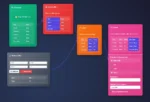In the realm of modern data strategy, discerning between exploratory analytical environments (sandboxes) and secure, established production data warehouses is crucial for every data-driven business. Decision-makers often grapple with blurred distinctions, which inevitably lead to complexity, inefficiencies, and even security risks. Beyond buzzwords and theoretical constraints, comprehending the practical implications of clearly establishing and maintaining boundaries between analytical sandboxes and production warehouses can be the differentiator between stagnation and thriving innovation. Let’s dive deeper into how strategically separating these two environments can significantly enhance your organization’s data management, security posture, analytical agility, and innovation potential.
Defining the Analytical Sandbox: Flexibility for Exploration
The analytical sandbox serves as a vibrant playground for your data scientists, analysts, and business intelligence teams. This dedicated workspace offers a flexible area to test hypotheses, experiment with cutting-edge technologies such as artificial intelligence (AI) and machine learning (ML), prototype rapidly, and visualize data creatively. Unlike rigid production environments, analytical sandboxes promote unfettered exploration and iterative learning, fostering a culture of informed curiosity and data-driven decision-making.
Whether your team is tracing complex dashboards using tools detailed in our article about tracing dashboards with Figma and Power BI, or testing the latest AI and ML algorithms as outlined in our post about AI and ML revolutionizing the data industry, this sandbox environment considerably shortens innovation cycles. Analysts can freely experiment without risking unintended impacts on enterprise-wide reporting services or operational data.
However, with flexibility comes responsibility. Without adequate oversight, sandbox environments can quickly become chaotic and fragmented, underscoring the necessity to establish clear boundaries, guidelines, and data governance policies from early on—setting your organization up for successful migrations from sandbox discoveries to enterprise-scale applications.
Understanding the Production Warehouse: Stability and Consistency
Contrasting with analytical sandboxes, production data warehouses prioritize stability, consistency, and robust security. These established environments hold the bedrock data that fuels critical business decisions, operational processes, and compliance reporting. In short, production warehouses are foundational to your organization’s informational reliability.
Because production warehouses often service large-scale operations, consistency is key—thus necessitating rigorous, standardized processes for extracting, loading, transforming, and querying data. Utilizing proven querying techniques such as the SELECT TOP statement in SQL or mastering core concepts of SQL joins for combining data, becomes invaluable in accurately accessing and presenting critical information without performance degradation.
The structured nature of production warehouses also means a necessary sensitivity toward complexity and maintenance overhead. Avoiding unnecessary SQL complexity—as examined in our article SQL Overkill: Why 90% of Your Queries are Too Complicated—can help businesses streamline performance. Furthermore, adhering to stringent security protocols, controlled access, and rigorous governance ensures the reliability and accuracy needed for optimal decision-making.
Best Practices for Establishing Clear Boundaries
Formalize Data Movement Between Environments
The first step towards establishing clear boundaries between your analytical sandbox and production warehouse is formalizing the processes through which data migrates between the two. A well-designed workflow will ensure that insights gained in the sandbox are vetted and adequately prepared before making their way upstream to production environments.
Begin by clearly documenting migration requirements, specifying data quality standards, validation processes, and acceptable data-staging areas. Collaborate closely with data governance teams to ensure compliance and security. Leveraging techniques from our article on real-time data processing with Node.js techniques and best practices can enhance data movement efficiency and minimize latency during migration.
Implement Effective Access Controls and Permissions
Clear boundaries also demand robust access control strategies. Restrict sandbox environments to qualified analysts and data scientists while employing more stringent rights and permissions in the production warehouse. Establish separate roles, policies, and identity management solutions to enforce controlled access and consistently protect sensitive data assets.
Regular audits and reviews of access privileges ensure that sensitive data is only accessible to those with appropriate permissions. These controls are crucial, especially as data volumes expand within your organization, underscoring the necessity for proactive security measures and clear separation between experimental and officially sanctioned data sources.
Reducing Complexity: Keep Data Architecture Lean and Agile
As businesses grow increasingly data-driven, complexity can quickly become the greatest enemy. Excessively elaborate scripts, unnecessary ETL jobs, and convoluted database queries within production warehouses often harm analytical speed and data warehouse performance. Regularly reviewing and optimizing your warehouse structure can mitigate these common issues.
Drawing from experience detailed in our guide on simplifying overly complex SQL queries, organizations can significantly simplify their production warehouse landscape. Utilize standardized data modeling techniques and follow a disciplined database schema design philosophy—leading to a leaner, agile, and easier-to-maintain warehouse, unburdened by excessive complexity.
Visual Insights – Less is More in Production Scenarios
Visualization design is another aspect where boundaries between analytical sandboxes and production warehouses become evident. In sandbox environments, analysts may freely explore elaborate visualizations and dashboards to gain insights or test new representations of data. However, production-level visualizations should prioritize clarity, relevance, and streamlined communication of essential insights.
As elaborated in our article advising businesses to avoid clutter and unnecessary elements in data visualization, it’s important to maintain discipline regarding minimalist and insightful visual storytelling at the production level. Ensuring visual clarity and an emphasis on user-centric design leads to quicker understanding, greater adoption of insights, and ultimately drives successful data-driven decision-making throughout your organization.
Leveraging Technology Expertise to Ease the Boundary Establishment
Eager to seamlessly create distinct boundaries between sandbox analytics and production warehouses, yet unsure how best to approach it? Partnering with seasoned professionals can significantly ease this transition and implementation process. Our firm’s deep data warehousing expertise can guide your teams in configuring robust, scalable, and secured warehouse environments tailored to your specific business needs and objectives.
Explore our comprehensive solutions on the data warehousing consulting services in Austin, Texas page, and discover how our expertise can streamline your warehouse implementation, design efficient data pipelines, and strengthen analytical capabilities. Whether it’s resolving challenging database issues, recovering disabled services, as in our tutorial about updating orchestrator service (UsoSvc), or mastering basics such as how to effortlessly start MySQL on Mac OSX, proactive engagement with expert consultants ensures that your boundaries are constructed thoughtfully, effectively, and securely aligned with industry best practices.
Conclusion: Be Strategic About Your Data Ecosystem
Establishing clear boundaries between analytical sandboxes and production warehouses is no longer simply an abstract idea—it’s a strategic necessity that directly impacts your organization’s operational efficiency, data governance, analytics agility, and innovation capability. By thoughtfully aligning exploration and experimentation within your analytical sandbox to robust, governed stability in your production warehouse, your business positions itself to maximize value from every byte it stores or analyzes.
Adopting the practices mentioned here, leaning on experienced advisors, and instilling a clarity-first mindset towards your data management strategies will foster agility, enhance security and reliability, and significantly propel your organization towards data-driven innovation and success. Embrace definitional clarity within your data ecosystem to find yourself well-equipped for today’s data-driven reality.



















